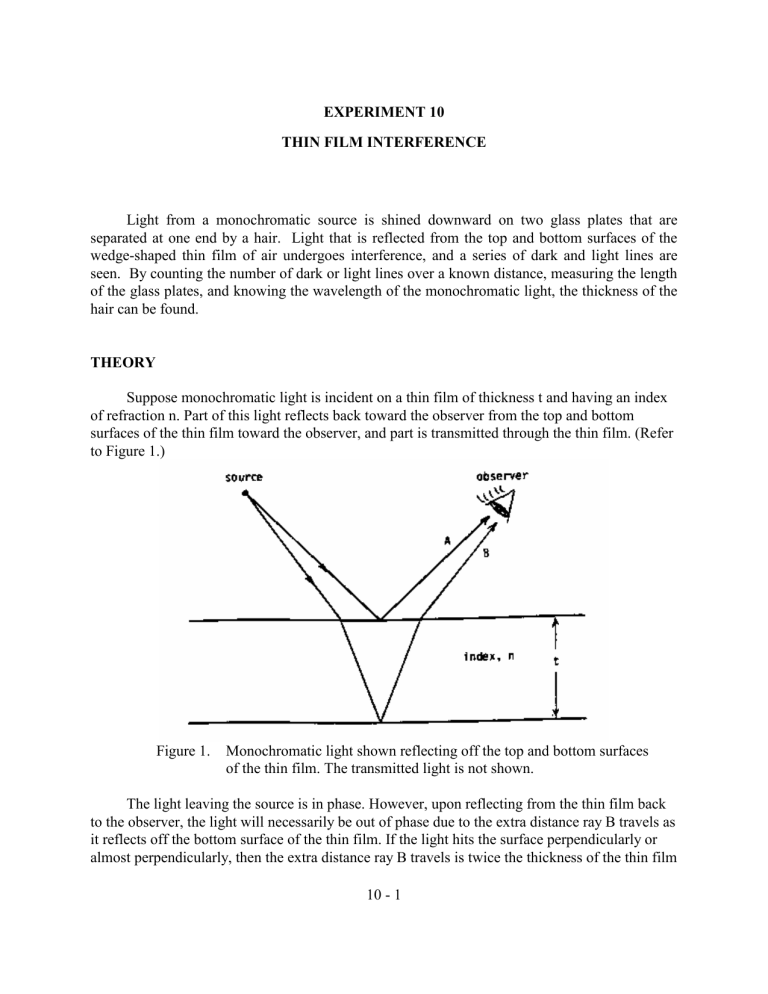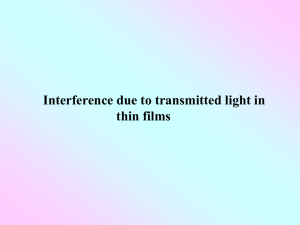EXPERIMENT 10

EXPERIMENT 10
THIN FILM INTERFERENCE
Light from a monochromatic source is shined downward on two glass plates that are separated at one end by a hair. Light that is reflected from the top and bottom surfaces of the wedge-shaped thin film of air undergoes interference, and a series of dark and light lines are seen. By counting the number of dark or light lines over a known distance, measuring the length of the glass plates, and knowing the wavelength of the monochromatic light, the thickness of the hair can be found.
THEORY
Suppose monochromatic light is incident on a thin film of thickness t and having an index of refraction n. Part of this light reflects back toward the observer from the top and bottom surfaces of the thin film toward the observer, and part is transmitted through the thin film. (Refer to Figure 1.)
Figure 1. Monochromatic light shown reflecting off the top and bottom surfaces of the thin film. The transmitted light is not shown.
The light leaving the source is in phase. However, upon reflecting from the thin film back to the observer, the light will necessarily be out of phase due to the extra distance ray B travels as it reflects off the bottom surface of the thin film. If the light hits the surface perpendicularly or almost perpendicularly, then the extra distance ray B travels is twice the thickness of the thin film
10 - 1
at the point where the light is incident. This extra distance and the corresponding phase differences are related to each other as phase difference = path difference ,
2
wavelength with in the thin film or
2
2 t
n
,
(1)
(2) where
is the phase difference, t is the thickness of the film, and
n is the wavelength of the light in the thin film. In this case, the thin film has an index of refraction n and
n =
/n, where
is the wavelength of the light in air. Equation (2) then becomes
2
2 t
, (3)
If two waves interfere and the phase difference between them is 2m
, where m = 0, 1, 2, ..., then constructive interference results. And, if the phase difference is 2(m – ½)
, where m = 0, 1,
2, ..., then destructive interference results. Other phase differences give partial constructive or destructive interference.
When the phase difference,
, in (3) is replaced by the values of the phase difference, the results are
2 t
m
. m
0 , 1 , 2 ,...
(4) for constructive interference, and
2 t
m
1
, m
0 , 1 , 2 ,...
(5)
2 for destructive interference.
An added complication arises in thin film interference. It is found that when light traveling in a medium of one index of refraction is reflected from a surface of higher index, a -
phase shift occurs. No phase shift occurs at the surface when the reflecting surface has a lower index of refraction. The result is that if the total number of phase shifts that rays A and B undergo is zero or an even number, then (4) and (5) hold as above. But, if an odd number of phase shifts occur, then (4) corresponds to destructive interference and (5) corresponds to constructive interference.
That is,
2 t
m
. m
0 , 1 , 2 ,...
(6)
10 - 2
for destructive interference, and
2 t
m
1
, m
0 , 1 , 2 ,...
(7)
2 for constructive interference.
For a wedge-shaped film of air between two glass plates a total of one phase shift occurs, so (6) and (7) are the appropriate expressions. A single phase shift occurs at the bottom surface of the thin film of air, but no phase shift occurs at the top surface. Each value of m in (6) corresponds to a dark line and in (7) a bright line. When m = 0 in (6), this indicates that the thickness of the film is zero (t = 0), so m = 0 corresponds to the dark line produced at the point of contact between the two glass plates. The next dark line away from the point of contact is m = 1, and so on.
In this experiment a wedge-shaped layer of air between two glass plates is produced by separating one end of the glass plates with a hair. (Refer to Figure 2.) When monochromatic light is shined on the plates from above, a series of bright and dark lines are seen. (In Figure 2 the bright and dark lines are indicated by the letters B and D, respectively.
Figure 2. A side view of the thin film of air. The distance between the lines
and the thickness of the film are greatly exaggerated.
If the number of dark lines are counted over a known distance d. similar triangles can be used to find the hair thickness T. That is, in the triangle PQR and the triangular wedge of air,
QR
PR
T
L
.
(8)
10 - 3
But QR =tt+N - tt where tt is the thickness of the film at the i th the film at the (i + N) th dark line, tt+N is the thickness of
dark line, and PR = d. Using (6) and setting M = t+ N then setting m =t and subtracting,
QR
t t
N
t t
i
N
2
i
2
N
2
, (9) where N is the number of dark lines in the distance d. Equation (8) then becomes
T
N
L
2
d
.
(10)
APPARATUS o sodium light source o two plane, parallel glass plates o micrometer o blank paper o ruler o 10 cm focal length lens
PROCEDURE a) Clean the surfaces of the two glass plates and handle them so that no smudges are left on their surfaces. b) Plug in and turn on the sodium light source. c) Carefully draw two parallel lines one centimeter apart on the notebook paper. This is the distance d.
Record d and the uncertainty,
d. d) Request a hair from the head of a member of your group and measure the diameter of the hair with the micrometer. Record this value and its uncertainty. (Be sure not to crush the hair when you tighten the micrometer.) e) Carefully place the hair between the two glass plates perpendicular to the length of the plates and close to one end. Do not press the plates together; this will crush the hair. f) Lay the plates down over the lines drawn on the notebook paper so that the length of the plates is perpendicular to the lines. Measure the distance from the point of contact of the glass plates to the position of the hair. Record the value L and its uncertainty,
L.
10 - 4
g) Adjust the position of the sodium lamp until the light from the lamp shines almost straight downward on the glass plates. Notice the bright and dark interference lines. h) Use the 10 cm focal length lens as a magnifying glass and count the number of dark lines between the one centimeter marks on the notebook paper. Record the number of lines, N, and the uncertainty in the count,
N. i) Have each person in the group repeat steps (d) and (h) for his or her own data.
ANALYSIS
The uncertainty in the thickness of the hair due to uncertainties in measurements is
T
T
N
N
L
L
d d
, (11) where the wavelength of the sodium light is assumed to be exactly 589 nm and the index of refraction of air is 1,000.
Calculate the thickness of the hair from (10) and its uncertainty from (11). Report these values and the value obtained from the micrometer reading in a table. Also graph these values on a one-dimensional graph.
QUESTION
1. It is hard to get the bars to be parallel in this experiment. Explain why the bars tend to be so wiggly.
2. Explain why it is necessary to use a special sodium vapor lamp for this experiment rather than an ordinary white lamp.
3. Explain how the number of bars to be counted would be affected if the lamp were changed to a different source producing red light. Would this make the uncertainty in the experiment smaller or greater?
4. Explain why it is better to place the hair as far as possible from the contact point of the glass plates.
5. How would dust and oil on the glass plates affect the results?
6. What percentage error would result from miscounting the bars by one?
10 - 5
7. How would the data and results of the experiment be affected ff instead of glass we had used a different transparent material for the plates?
10 - 6




